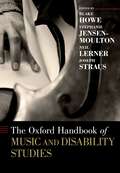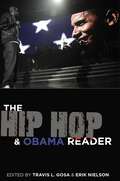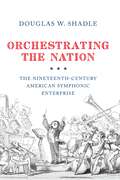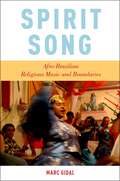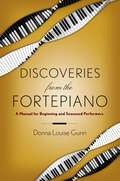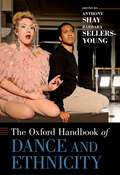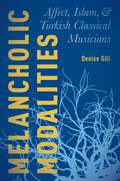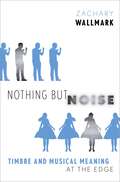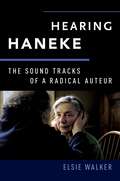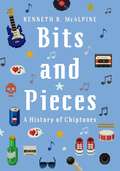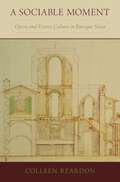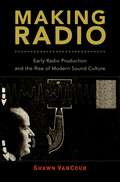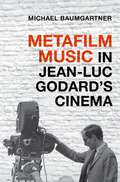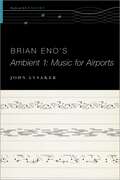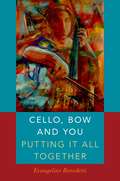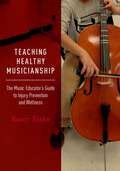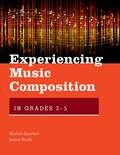- Table View
- List View
The Oxford Handbook of Music and Disability Studies (Oxford Handbooks)
by Blake Howe, Stephanie Jensen-Moulton, Neil Lerner and Joseph StrausThe Oxford Handbook of Disability Studies represents a comprehensive state of current research for the field of Disability Studies and Music. The forty-two chapters in the book span a wide chronological and geographical range, from the biblical, the medieval, and the Elizabethan, through the canonical classics of the eighteenth and nineteenth centuries, up to modernist styles and contemporary musical theater and popular genres, with stops along the way in post-Civil War America, Ghana and the South Pacific, and many other interesting times and places. Disability is a broad, heterogeneous, and porous identity, and that diversity is reflected in the variety of bodily conditions under discussion here, including autism and intellectual disability, deafness, blindness, mobility impairment often coupled with bodily difference, and cognitive and intellectual impairments. Amid this diversity of time, place, style, medium, and topic, the chapters share two core commitments. First, they are united in their theoretical and methodological connection to Disability Studies, especially its central idea that disability is a social and cultural construction. Disability both shapes and is shaped by culture, including musical culture. Second, these essays individually and collectively make the case that disability is not something at the periphery of culture and music, but something central to our art and to our humanity.
HIP HOP & OBAMA READER C
by Travis L. Gosa and Erik NielsonFeaturing a foreword by Tricia Rose and an Afterword by Cathy J. Cohen Barack Obama flipped the script on more than three decades of conventional wisdom when he openly embraced hip hop--often regarded as politically radioactive--in his presidential campaigns. Just as important was the extent to which hip hop artists and activists embraced him in return. This new relationship fundamentally altered the dynamics between popular culture, race, youth, and national politics. But what does this relationship look like now, and what will it look like in the decades to come? The Hip Hop & Obama Reader attempts to answer these questions by offering the first systematic analysis of hip hop and politics in the Obama era and beyond. Over the course of 14 chapters, leading scholars and activists offer new perspectives on hip hop's role in political mobilization, grassroots organizing, campaign branding, and voter turnout, as well as the ever-changing linguistic, cultural, racial, and gendered dimensions of hip hop in the U.S. and abroad. Inviting readers to reassess how Obama's presidency continues to be shaped by the voice of hip hop and, conversely, how hip hop music and politics have been shaped by Obama, The Hip Hop & Obama Reader critically examines hip hop's potential to effect social change in the 21st century. This volume is essential reading for scholars and fans of hip hop, as well as those interested in the shifting relationship between democracy and popular culture.
Orchestrating the Nation: The Nineteenth-Century American Symphonic Enterprise
by Douglas ShadleDuring the nineteenth century, nearly one hundred symphonies were written by over fifty composers living in the United States. With few exceptions, this repertoire is virtually forgotten today. In Orchestrating the Nation: The Nineteenth-Century American Symphonic Enterprise, author Douglas W. Shadle explores the stunning stylistic diversity of this substantial repertoire and uncovers why it failed to enter the musical mainstream. Throughout the century, Americans longed for a distinct national musical identity. As the most prestigious of all instrumental genres, the symphony proved to be a potent vehicle in this project as composers found inspiration for their works in a dazzling array of subjects, including Niagara Falls, Hiawatha, and Western pioneers. With a wealth of musical sources at his disposal, including never-before-examined manuscripts, Shadle reveals how each component of the symphonic enterprise-from its composition, to its performance, to its immediate and continued reception by listeners and critics-contributed to competing visions of American identity. Employing an innovative transnational historical framework, Shadle's narrative covers three continents and shows how the music of major European figures such as Beethoven, Schumann, Wagner, Liszt, Brahms, and Dvorák exerted significant influence over dialogues about the future of American musical culture. Shadle demonstrates that the perceived authority of these figures allowed snobby conductors, capricious critics, and even orchestral musicians themselves to thwart the efforts of American symphonists despite widespread public support of their music. Consequently, these works never entered the performing canons of American orchestras. An engagingly written account of a largely unknown repertoire, Orchestrating the Nation shows how artistic and ideological debates from the nineteenth century continue to shape the culture of American orchestral music today.
SPIRIT SONG C: Afro-Brazilian Religious Music and Boundaries
by Marc GidalIn Spirit Song: Afro-Brazilian Religious Music and Boundaries, Marc Gidal investigates how and why a multi-faith community in southern Brazil utilizes music to combine and segregate three Afro-Brazilian religions: Umbanda, Quimbanda, and Batuque. Combining ethnomusicology and symbolic boundary studies, Gidal advances a theory of musical boundary-work: the ways music reinforces, bridges, or blurs boundaries, whether for personal, social, spiritual, or political purposes. Gidal focuses on spirit-mediumship rituals and their musical accompaniment, exploring how the Afro-gaucho religious community employs music and rituals to variously promote innovation and egalitarianism in Umbanda and Quimbanda, while it reinforces musical preservation and hierarchies in Batuque. Religious and musical leaders carefully restrict the cosmologies, ceremonial sequences, and sung prayers of one religion from affecting the others so as to safeguard Batuque's African heritage. Members of disenfranchised populations view the religions as vehicles for empowerment, whether based on race-ethnicity, gender, or religious belief; and innovations in ritual music reflect this activism. These rituals come to life through illustrative video and audio examples on the book's companion website. The first book in English to focus on music in Afro-Brazilian religions, Spirit Song is a landmark study that will be of interest to ethnomusicologists, anthropologists, and religious studies scholars.
DISCOVERIES FROM THE FORTEPIANO C: A Manual for Beginning and Seasoned Performers
by Donna Louise GunnDiscoveries from the Fortepiano uncovers eighteenth-century performance practices and philosophical beliefs, enabling modern performers to craft an authentic, historically influenced style. Using a variety of primary sources and scholarly interpretations, noted keyboard pedagogue Donna Gunn offers a guide on Classical Era piano performance practice that is at once accurate to the scholarship and accessible to the performer. Gunn surveys and explains eighteenth-century music notational language, and from this develops tools that get at the heart of the otherwise enigmatic sound aesthetic of the era. Through over 100 music examples, Gunn provides specific answers to performance questions regarding period influences on the modern piano, including technique, dynamics, articulation, rhythm, ornamentation, and pedaling. A Companion Website houses recordings of three versions for each music example that demonstrate different interpretations and deliveries. Gunn encourages the reader to study the sources, listen carefully, and experiment with the past in the present. Remarkably researched and engagingly written, Discoveries from the Fortepiano is an indispensable aid to any pianist who seeks both an academically and artistically sound approach to performing in the Classical Era style.
The Oxford Handbook of Dance and Ethnicity (Oxford Handbooks)
by Anthony Shay and Barbara Sellers-YoungDance intersects with ethnicity in a powerful variety of ways and at a broad set of venues. Dance practices and attitudes about ethnicity have sometimes been the source of outright discord, as when African Americans were - and sometimes still are - told that their bodies are 'not right' for ballet, when Anglo Americans painted their faces black to perform in minstrel shows, when 19th century Christian missionaries banned the performance of particular native dance traditions throughout much of Polynesia, and when the Spanish conquistadors and church officials banned sacred Aztec dance rituals. More recently, dance performances became a locus of ethnic disunity in the former Yugoslavia as the Serbs of Bosnia attended dance concerts but only applauded for the Serbian dances, presaging the violent disintegration of that failed state. The Oxford Handbook of Dance and Ethnicity brings together scholars from across the globe in an investigation of what it means to define oneself in an ethnic category and how this category is performed and represented by dance as an ethnicity. Newly-commissioned for the volume, the chapters of the book place a reflective lens on dance and its context to examine the role of dance as performed embodiment of the historical moments and associated lived identities. In bringing modern dance and ballet into the conversation alongside forms more often considered ethnic, the chapters ask the reader to contemplate previous categories of folk, ethnic, classical, and modern. From this standpoint, the book considers how dance maintains, challenges, resists or in some cases evolves new forms of identity based on prior categories. Ultimately, the goal of the book is to acknowledge the depth of research that has been undertaken and to promote continued research and conceptualization of dance and its role in the creation of ethnicity. Dance and ethnicity is an increasingly active area of scholarly inquiry in dance studies and ethnomusicology alike and the need is great for serious scholarship to shape the contours of these debates. The Oxford Handbook of Dance and Ethnicity provides an authoritative and up-to-date survey of original research from leading experts which will set the tone for future scholarly conversation.
Melancholic Modalities: Affect, Islam, and Turkish Classical Musicians
by Denise GillToday, teachers and performers of Turkish classical music intentionally cultivate melancholies, despite these affects being typically dismissed as remnants of the Ottoman Empire. Melancholic Modalities is the first in-depth historical and ethnographic study of the practices socialized by musicians who enthusiastically teach and perform a present-day genre substantially rooted in the musics of the Ottoman court and elite Mevlevi Sufi lodges. Author Denise Gill analyzes how melancholic music-making emerges as pleasurable, spiritually redeeming, and healing for both the listener and performer. Focusing on the diverse practices of musicians who deploy and circulate melancholy in sound, Gill interrogates the constitutive elements of these musicians' modalities in the context of emergent neoliberalism, secularism, political Islamism, Sufi devotionals, and the politics of psychological health in Turkey today. In an essential contribution to the study of ethnomusicology and psychology, Gill develops rhizomatic analyses to allow for musicians' multiple interpretations to be heard. Melancholic Modalities uncovers how emotion and musical meaning are connected, and how melancholy is articulated in the world of Turkish classical musicians. With her innovative concept of "bi-aurality," Gill's book forges new possibilities for the historical and ethnographic analyses of musics and ideologies of listening for music scholars.
Nothing but Noise: Timbre and Musical Meaning at the Edge
by Zachary WallmarkNothing but Noise: Timbre and Musical Meaning at the Edge explores how timbre shapes musical affect and meaning. Integrating perspectives from musicology with the cognitive sciences, author Zachary Wallmark advances a novel model of timbre interpretation that takes into account the bodily, sensorimotor dynamics of sound production and perception. The contribution of timbre to musical experience is clearest in drastic situations where meaning is itself contested; that is, in polarizing contexts of reception where evaluation of "musical" timbre by some listeners collides headlong against a competing claim-that it is just "noise." Taking this ubiquitous moment as a starting point, the book explores affect, reception, and timbre semantics through diverse cultural-historical case studies that frustrate the acoustic and perceptual boundary between musical sound and noise. Nothing but Noise includes chapters on the racial and gender politics in the reception of free jazz saxophone "screaming" in the late 1960s; an analysis of contested timbral ideals in the performance practices of the Japanese shakuhachi flute; and an historical examination of the overlooked role of "brutal" timbres in the moral panic over heavy metal in the eighties and nineties. The book closes with a discussion of the slippery social fault lines separating perceptions of musical sound from noise and the ethical stakes of encountering another's "aural face."
Nothing but Noise: Timbre and Musical Meaning at the Edge
by Zachary WallmarkNothing but Noise: Timbre and Musical Meaning at the Edge explores how timbre shapes musical affect and meaning. Integrating perspectives from musicology with the cognitive sciences, author Zachary Wallmark advances a novel model of timbre interpretation that takes into account the bodily, sensorimotor dynamics of sound production and perception. The contribution of timbre to musical experience is clearest in drastic situations where meaning is itself contested; that is, in polarizing contexts of reception where evaluation of "musical" timbre by some listeners collides headlong against a competing claim-that it is just "noise." Taking this ubiquitous moment as a starting point, the book explores affect, reception, and timbre semantics through diverse cultural-historical case studies that frustrate the acoustic and perceptual boundary between musical sound and noise. Nothing but Noise includes chapters on the racial and gender politics in the reception of free jazz saxophone "screaming" in the late 1960s; an analysis of contested timbral ideals in the performance practices of the Japanese shakuhachi flute; and an historical examination of the overlooked role of "brutal" timbres in the moral panic over heavy metal in the eighties and nineties. The book closes with a discussion of the slippery social fault lines separating perceptions of musical sound from noise and the ethical stakes of encountering another's "aural face."
Hearing Haneke: The Sound Tracks of a Radical Auteur (Oxford Music/Media Series)
by Elsie WalkerMichael Haneke's films subject us to extreme experiences of disturbance, desperation, grief, and violence. They are unsoftened by music, punctuated by accosting noises, shaped by painful silences, and charged with aggressive dialogue. The sound tracks are even more traumatic to hear than his stories are to see, but they also offer us the transformative possibilities of reawakened sonic awareness. Haneke's use of sound redefines cinema in ways that can help us re-hear everything-including our own voices, and everything around us-better. Though Haneke's films make exceptional demands on us, he is among the most celebrated of living auteurs: he is two-time receipt of the Palme D'Or at Cannes Film Festival (for The White Ribbon (2009) and Amour (2012)), and Academy Award winner of Best Foreign Language Film (for Amour), along with numerous other awards. The radical confrontationality of his cinema makes him an internationally controversial, as well as revered, subject. Hearing Haneke is the first book-length study of the sound tracks that define this living legacy. This book explores the haunting, subversive, and political significance of all aural elements through Haneke's major feature films (dialogue, sound effects, silences, and music), all of which are meticulously conducted by him. Many critics read Haneke as coolly dispassionate about showing scenes of humanity under threat, but Hearing Haneke argues that all facets of his sound tracks stress humane understanding and the importance of compassion. This book provides exceptionally detailed analyses of all Haneke's most celebrated films: including The Seventh Continent, Funny Games, Code Unknown, The Piano Teacher, Caché, The White Ribbon, and Amour. The writing brings together film theory, musicology, history, and cultural studies in ways that resonate broadly. Hearing Haneke will matter to anyone who cares about the power of art to inspire progressive change.
HEARING HANEKE OMMS C: The Sound Tracks of a Radical Auteur (Oxford Music/Media Series)
by Elsie WalkerMichael Haneke's films subject us to extreme experiences of disturbance, desperation, grief, and violence. They are unsoftened by music, punctuated by accosting noises, shaped by painful silences, and charged with aggressive dialogue. The sound tracks are even more traumatic to hear than his stories are to see, but they also offer us the transformative possibilities of reawakened sonic awareness. Haneke's use of sound redefines cinema in ways that can help us re-hear everything-including our own voices, and everything around us-better. Though Haneke's films make exceptional demands on us, he is among the most celebrated of living auteurs: he is two-time receipt of the Palme D'Or at Cannes Film Festival (for The White Ribbon (2009) and Amour (2012)), and Academy Award winner of Best Foreign Language Film (for Amour), along with numerous other awards. The radical confrontationality of his cinema makes him an internationally controversial, as well as revered, subject. Hearing Haneke is the first book-length study of the sound tracks that define this living legacy. This book explores the haunting, subversive, and political significance of all aural elements through Haneke's major feature films (dialogue, sound effects, silences, and music), all of which are meticulously conducted by him. Many critics read Haneke as coolly dispassionate about showing scenes of humanity under threat, but Hearing Haneke argues that all facets of his sound tracks stress humane understanding and the importance of compassion. This book provides exceptionally detailed analyses of all Haneke's most celebrated films: including The Seventh Continent, Funny Games, Code Unknown, The Piano Teacher, Caché, The White Ribbon, and Amour. The writing brings together film theory, musicology, history, and cultural studies in ways that resonate broadly. Hearing Haneke will matter to anyone who cares about the power of art to inspire progressive change.
Bits and Pieces: A History of Chiptunes
by Kenneth B. McAlpineBits and Pieces tells the story of chiptune, a style of lo-fi electronic music that emerged from the first generation of video game consoles and home computers in the late 1970s and early 1980s. Through ingenuity and invention, musicians and programmers developed code that enabled the limited hardware of those early 8-bit machines to perform musical feats that they were never designed to achieve. In time, that combination of hardware and creative code came to define a unique 8-bit sound that imprinted itself on a generation of gamers. For a new generation of musicians, this music has currency through the chipscene, a vibrant musical subculture that repurposes obsolete gaming hardware. It's performative: raw and edgy, loaded with authenticity and driven by a strong DIY ethic. It's more punk than Pac-Man, and yet, it's part of that same story of ingenuity and invention; 8-bit hardware is no longer a retired gaming console, but a quirky and characterful musical instrument. Taking these consoles to the stage, musicians fuse 8-bit sounds with other musical styles - drum'n'bass, jungle, techno and house - to create a unique contemporary sound. Analyzing musical structures and technological methods used with chiptune, Bits and Pieces traces the simple beeps of the earliest arcade games, through the murky shadows of the digital underground, to global festivals and movie soundtracks.
BITS & PIECES C: A History of Chiptunes
by Kenneth B. McAlpineBits and Pieces tells the story of chiptune, a style of lo-fi electronic music that emerged from the first generation of video game consoles and home computers in the late 1970s and early 1980s. Through ingenuity and invention, musicians and programmers developed code that enabled the limited hardware of those early 8-bit machines to perform musical feats that they were never designed to achieve. In time, that combination of hardware and creative code came to define a unique 8-bit sound that imprinted itself on a generation of gamers. For a new generation of musicians, this music has currency through the chipscene, a vibrant musical subculture that repurposes obsolete gaming hardware. It's performative: raw and edgy, loaded with authenticity and driven by a strong DIY ethic. It's more punk than Pac-Man, and yet, it's part of that same story of ingenuity and invention; 8-bit hardware is no longer a retired gaming console, but a quirky and characterful musical instrument. Taking these consoles to the stage, musicians fuse 8-bit sounds with other musical styles - drum'n'bass, jungle, techno and house - to create a unique contemporary sound. Analyzing musical structures and technological methods used with chiptune, Bits and Pieces traces the simple beeps of the earliest arcade games, through the murky shadows of the digital underground, to global festivals and movie soundtracks.
A Sociable Moment: Opera and Festive Culture in Baroque Siena
by Colleen ReardonAfter their military defeat by the Florentines in the mid-sixteenth century, the citizens of Siena turned from politics to celebratory, social occasions to express their civic identity and show their capacity for collective action. In the first major work of its kind, Colleen Reardon opens a window on the ways in which the Sienese absorbed the new genre of opera into their own festive apparatus and challenges the prevailing view that operatic productions in the city were merely an extension of Medici power to the provinces. It was, rather, members of the expatriate Chigi family who exploited the festive impulse of their countrymen, coordinating operatic performances with their triumphant visits home by activating ties of friendship and family as well as connections to Sienese institutions, most notably the Assicurate, possibly the first all-female academy in Italy. If the Chigi proved successful at inserting opera into larger patterns of sociability that conveyed the very essence of what it meant to be Sienese (senesità), their successor, the flamboyant playwright and librettist Girolamo Gigli, struggled in his attempts to transform operatic performances into professional enterprises. Fluidly written and richly embellished with anecdotes from historical chronicles, A Sociable Moment offers insight into the Sienese experience with opera during the genre's rapid expansion throughout the Italian peninsula during the late seventeenth and early eighteenth centuries.
Making Radio: Early Radio Production and the Rise of Modern Sound Culture
by Shawn VanCourThe opening decades of the twentieth century witnessed a profound transformation in the history of modern sound media, with workers in U.S. film, radio, and record industries developing pioneering production methods and performance styles tailored to emerging technologies of electric sound reproduction that would redefine dominant forms and experiences of popular audio entertainment. Focusing on broadcasting's initial expansion during the 1920s, Making Radio explores the forms of creative labor pursued for the medium in the period prior to the better-known network era, assessing their role in shaping radio's identity and identifying affinities with parallel practices pursued for conversion-era film and phonography. Tracing programming forms adopted by early radio writers and programmers, production techniques developed by studio engineers, and performance styles cultivated by on-air talent, it shows how radio workers negotiated a series of broader industrial and cultural pressures to establish best practices for their medium that reshaped popular forms of music, drama, and public oratory and laid the foundation for a new era of electric sound entertainment.
Making Radio: Early Radio Production and the Rise of Modern Sound Culture
by Shawn VanCourThe opening decades of the twentieth century witnessed a profound transformation in the history of modern sound media, with workers in U.S. film, radio, and record industries developing pioneering production methods and performance styles tailored to emerging technologies of electric sound reproduction that would redefine dominant forms and experiences of popular audio entertainment. Focusing on broadcasting's initial expansion during the 1920s, Making Radio explores the forms of creative labor pursued for the medium in the period prior to the better-known network era, assessing their role in shaping radio's identity and identifying affinities with parallel practices pursued for conversion-era film and phonography. Tracing programming forms adopted by early radio writers and programmers, production techniques developed by studio engineers, and performance styles cultivated by on-air talent, it shows how radio workers negotiated a series of broader industrial and cultural pressures to establish best practices for their medium that reshaped popular forms of music, drama, and public oratory and laid the foundation for a new era of electric sound entertainment.
Metafilm Music in Jean-Luc Godard's Cinema (Oxford Music / Media)
by Michael BaumgartnerHailed as a leading innovator of visual montage, unique storytelling style, and ground-breaking cinematography, Jean-Luc Godard is a prominent pioneer in sculpting complex soundtracks altering the familiar relationship between sound and image, but his achievements in sound have been largely overlooked. Such a lacuna in the extensive research on Godard's work is unfortunate, as Godard's lifelong preoccupation of exploring self-reflexively all aspects of filmmaking particularly affects film music. With the novel approach of metafilm music, extrapolated from Jean-Luc Godard's oeuvre, this book not only closes up a crucial gap in Godard research, but also offers detailed analyses of the music as metafilm music in Contempt, Alphaville, Band of Outsiders, Pierrot le fou, First Name: Carmen, Histoire(s) du cinéma, among other films and video productions. The innovative scholarly concept of metafilm music, enriching the burgeoning field of music in audio-visual media, describes how Godard thinks about film music with film music. This book thus provides a thorough examination of Godard's self-reflexive approach to film music which has resulted in a lifelong creation of multi-layered soundtracks pushing the envelope of film music and sound to the limit.
Metafilm Music in Jean-Luc Godard's Cinema (Oxford Music / Media)
by Michael BaumgartnerHailed as a leading innovator of visual montage, unique storytelling style, and ground-breaking cinematography, Jean-Luc Godard is a prominent pioneer in sculpting complex soundtracks altering the familiar relationship between sound and image, but his achievements in sound have been largely overlooked. Such a lacuna in the extensive research on Godard's work is unfortunate, as Godard's lifelong preoccupation of exploring self-reflexively all aspects of filmmaking particularly affects film music. With the novel approach of metafilm music, extrapolated from Jean-Luc Godard's oeuvre, this book not only closes up a crucial gap in Godard research, but also offers detailed analyses of the music as metafilm music in Contempt, Alphaville, Band of Outsiders, Pierrot le fou, First Name: Carmen, Histoire(s) du cinéma, among other films and video productions. The innovative scholarly concept of metafilm music, enriching the burgeoning field of music in audio-visual media, describes how Godard thinks about film music with film music. This book thus provides a thorough examination of Godard's self-reflexive approach to film music which has resulted in a lifelong creation of multi-layered soundtracks pushing the envelope of film music and sound to the limit.
Brian Eno's Ambient 1: Music for Airports (The Oxford Keynotes Series)
by John T. LysakerBrian Eno's seminal album Ambient 1: Music for Airports continues to fascinate and charm audiences, not only as a masterpiece of ambient music, but as a powerful and transformative work of art. Author John T. Lysaker situates this album in the context of twentieth-century art music, where its ambitions and contributions to avant garde music practice become even more apparent. To appreciate the album's multifaceted character, Lysaker advocates for "prismatic listening," an attentiveness that continually shifts registers in the knowledge that no single approach can grasp the work as a whole. Exploring each of the album's four tracks and their unique sonic arrangements, Brian Eno's Ambient 1: Music for Airports argues that the album must be approached from at least three angles: as an ambient contribution to lived environments that draws upon cybernetics and the experiments of Erik Satie, as an exploration of what John Cage has termed the "activity of sounds," and as a work of conceptual art that asks us to think freshly about artistic creativity, listening, and the broad ecology of interactions that not only make art possible, but the full range of human meaning. If one listens in this way, Music for Airports becomes a sonic image that blurs the nature-culture distinction and rescues the most interesting concerns of avant-garde music from the social isolation of concert halls and performance spaces.
BRIAN ENO'S AMBIENT 1 OKS C (The Oxford Keynotes Series)
by John T. LysakerBrian Eno's seminal album Ambient 1: Music for Airports continues to fascinate and charm audiences, not only as a masterpiece of ambient music, but as a powerful and transformative work of art. Author John T. Lysaker situates this album in the context of twentieth-century art music, where its ambitions and contributions to avant garde music practice become even more apparent. To appreciate the album's multifaceted character, Lysaker advocates for "prismatic listening," an attentiveness that continually shifts registers in the knowledge that no single approach can grasp the work as a whole. Exploring each of the album's four tracks and their unique sonic arrangements, Brian Eno's Ambient 1: Music for Airports argues that the album must be approached from at least three angles: as an ambient contribution to lived environments that draws upon cybernetics and the experiments of Erik Satie, as an exploration of what John Cage has termed the "activity of sounds," and as a work of conceptual art that asks us to think freshly about artistic creativity, listening, and the broad ecology of interactions that not only make art possible, but the full range of human meaning. If one listens in this way, Music for Airports becomes a sonic image that blurs the nature-culture distinction and rescues the most interesting concerns of avant-garde music from the social isolation of concert halls and performance spaces.
Cello, Bow and You: Putting it All Together
by Evangeline BenedettiWritten for the cellist looking for an approach that demystifies cello playing, Cello, Bow and You is an innovative text in the field of string pedagogy written by a 40+ year veteran of the New York Philharmonic Orchestra and certified teacher of the Alexander Technique. Author Evangeline Benedetti has a unique voice and approach, and invites cellists of all levels to explore, make discoveries and organically internalize technique. Benedetti's approach compliments the work that students do with their teachers by encouraging them to be more aware of themselves and responsive to internal and external guidance. Cello, Bow and You allows students and professionals access to Benedetti's vast performance and teaching experience. She has pioneered an approach to playing that is a synthesis of the cellist's musical thought, the knowledge of the dynamic properties of the instrument and bow, and the ability to move effectively according to the mechanics of the human body. The synergy of these elements leads to physically healthy playing and frees players to be musically expressive. Written in engaging, informal prose, the book is a must-read for cellists and cello teachers - beginning, intermediate, or professional.
CELLO, BOW & YOU C
by Evangeline BenedettiWritten for the cellist looking for an approach that demystifies cello playing, Cello, Bow and You is an innovative text in the field of string pedagogy written by a 40+ year veteran of the New York Philharmonic Orchestra and certified teacher of the Alexander Technique. Author Evangeline Benedetti has a unique voice and approach, and invites cellists of all levels to explore, make discoveries and organically internalize technique. Benedetti's approach compliments the work that students do with their teachers by encouraging them to be more aware of themselves and responsive to internal and external guidance. Cello, Bow and You allows students and professionals access to Benedetti's vast performance and teaching experience. She has pioneered an approach to playing that is a synthesis of the cellist's musical thought, the knowledge of the dynamic properties of the instrument and bow, and the ability to move effectively according to the mechanics of the human body. The synergy of these elements leads to physically healthy playing and frees players to be musically expressive. Written in engaging, informal prose, the book is a must-read for cellists and cello teachers - beginning, intermediate, or professional.
Teaching Healthy Musicianship: The Music Educator's Guide to Injury Prevention and Wellness
by Nancy TaylorWritten by a professional musician who is also a certified occupational therapist, Teaching Healthy Musicianship first and foremost help music educators avoid common injuries that they themselves encounter, and in the process it also equips them with the tools they need to instill healthy musicianship practices in their students. Author Nancy Taylor combines her two unique skill sets to provide a model for injury prevention that is equally cognizant of the needs of music educators and their students. Through practical explanation of body mechanics, ergonomics, and the performance-related health problems and risk factors unique to musicianship, she gives music educators the tools they need to first practice healthy posture, body mechanics, environmental safety, and ergonomics, and then to introduce these same practices to their students. Thoroughly illustrated with 125 photographs, this book is a key resource for preservice and inservice teachers of middle school and high school band, orchestra, choir and general music.
Experiencing Music Composition in Grades 3-5 (Experiencing Music Composition)
by Michele Kaschub Janice SmithExperiencing Music Composition in Grades 3-5 is a practical guide to new, innovative, and natural composition techniques for young composers. Music Educators Michele Kaschub and Janice Smith bring a wealth of experience to bear a unique and thoughtfully curated series of materials that help teachers connect music education to young composers' everyday emotions and activities . Divided into four sections, Kaschub and Smith's book illustrates a creative roadmap for instilling a sense of creative independence in students ages 8-11. The first section introduces readers to three distinct compositional ideals that are as educationally significant as the music they help create: feelingful intention, musical expressivity, and artistic craftsmanship. These capacities help springboard children's work from sounds and brief musical gestures to thoughtfully created, expressive musical pieces. Section 2 includes fun and imaginative lessons that are accompanied by Sketchpages-graphic worksheets that support deep consideration of a project's purpose during the compositional process. Lessons also include invaluable suggestions for productive sharing in a variety of formats. Section 3 offers guidance and strategies for sharing work, providing feedback, and encouraging future growth in a manner that fosters a positive learning experience and acknowledges each composer's musical autonomy. Section 4 contains additional teacher guides focused on creating original music in different genres. These guides outline multiple approaches to corresponding lessons and jumpstart activity while serving as developmental models. Experiencing Music Composition: Grades 3-5 offers new ways to promote not only creative intuition in children but also independent thought, preparing students for a fulfilling relationship with music.
EXPERIENCING MUSIC GRADES 3-5 EMC C (Experiencing Music Composition)
by Janice Smith Michele KaschubExperiencing Music Composition in Grades 3-5 is a practical guide to new, innovative, and natural composition techniques for young composers. Music Educators Michele Kaschub and Janice Smith bring a wealth of experience to bear a unique and thoughtfully curated series of materials that help teachers connect music education to young composers' everyday emotions and activities . Divided into four sections, Kaschub and Smith's book illustrates a creative roadmap for instilling a sense of creative independence in students ages 8-11. The first section introduces readers to three distinct compositional ideals that are as educationally significant as the music they help create: feelingful intention, musical expressivity, and artistic craftsmanship. These capacities help springboard children's work from sounds and brief musical gestures to thoughtfully created, expressive musical pieces. Section 2 includes fun and imaginative lessons that are accompanied by Sketchpages-graphic worksheets that support deep consideration of a project's purpose during the compositional process. Lessons also include invaluable suggestions for productive sharing in a variety of formats. Section 3 offers guidance and strategies for sharing work, providing feedback, and encouraging future growth in a manner that fosters a positive learning experience and acknowledges each composer's musical autonomy. Section 4 contains additional teacher guides focused on creating original music in different genres. These guides outline multiple approaches to corresponding lessons and jumpstart activity while serving as developmental models. Experiencing Music Composition: Grades 3-5 offers new ways to promote not only creative intuition in children but also independent thought, preparing students for a fulfilling relationship with music.
